H2020 - ARTEM
Funding source:
|
Horizon H2020
|
Start: |
2017
|
End: |
2021 |
ARTEM (Aircraft noise Reduction Technologies and related Environmental iMpact) is a four-year research project devoted to the development of novel noise reduction technologies for low-noise 2035 and 2050 aircraft configurations.
The first core topic of ARTEM is the development of innovative technologies for the reduction of aircraft noise at the source. The approach moves beyond the reduction of isolated noise sources as pure fan or landing gear noise and addresses the interaction of various components and sources - which often contributes significantly to the overall noise emission of the aircraft.
Secondly, ARTEM addresses innovative concepts for the efficient damping of engine noise and other sources by the investigation of dissipative surface materials and liners. The development work will mature, and subsequently down select these technologies by comparative testing in a single relevant test setup. Furthermore, noise shielding potential for future aircraft configurations will be investigated.
The noise reduction technologies will be coupled to the modelling of future aircraft configurations as the blended wing body (BWB) and other innovative concepts with integrated engines and distributed electrical propulsion. The impact of those new configurations with low noise technology will be assessed in several ways including industry tools, airport scenario predictions, and auralization.
Initiated by the Association of European Research Establishments in Europe (EREA), ARTEM follows a holistic approach for noise reduction of future aircrafts and provides enablers for quiet air traffic of the future which is an important part of EREAs Future Sky initiative.
EPFL-LTS2 Task in ARTEM
EPFL is committed in ARTEM through a collaboration between the Signal Processing Laboratory LTS2 and the Swiss Plasma Center SPC. They aim at developping a novel active noise control strategy based on plasma actuators, in order to achieve significant noise reduction at the engine level, while complying with environmental specifications (harsh environment of the engine nacelle). For that , the task is split into the following:
- identification and development of a dedicated plasma actuator capable of undertaking active noise control feature (ie. real time reaction to incident sound field)
- identification of control strategies applicable to the plasma actuator
- test in laboratory conditions
- test in areoacoustic wind tunnel test facilities
Progress made so far in the project (as per 08/31/2021)
- Development of a customized Corona Discharge (CD) actuator, capable of rendering acoustic signals with satisfactory linearity
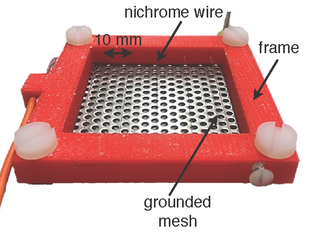
- Development of a Hybrid active-passive sound absorption of the CD actuator (using a resistive layer to damp sound energy)
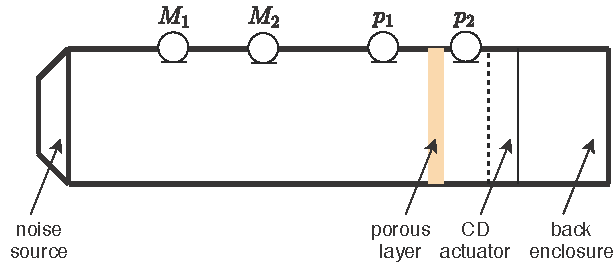 |
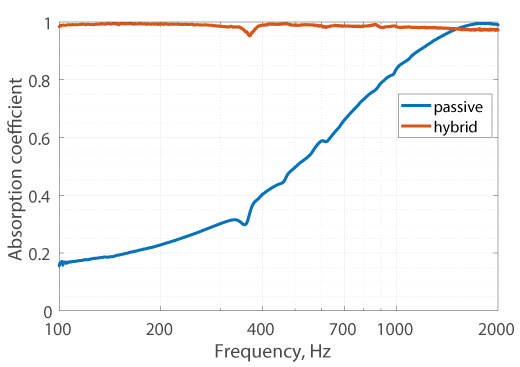 |
| Impedance tube measurement setup (left: source, right: hybrid passive/active sound absorber) | Measured absorption coefficient with hybrid passive/active termination (control off/on) |
- development of a feedback active sound absorption concept on the plasma actuator
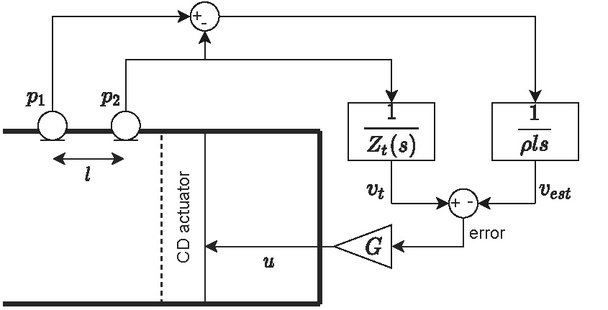 |
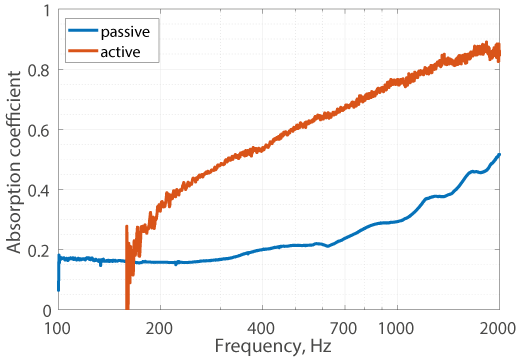 |
| Active feedback control architecture on the plasma actuator | Measured absorption coefficient with feedback-based plasma actuator (control off/on) |
- Development of an analytical model of the plasma actuator
- Based on the analytical model, development of a broadband active plasma sound absorber concept (feedforward control using the transducer itself as absorber)
- Outstanding sound absorption performance (<95% over at least 100 - 2000 Hz)
Publications
- S. Sergeev et al,Development of a plasma electroacoustic actuator for active noise control applications, Journal of Physics D: Applied Physics, 53, 495202 (2020)
- S. Sergeev et al, Corona discharge for active sound absorption, Proc. of e-Forum Acusticum 2020, Lyon France (2020).
- S. Sergeev et al, Corona Discharge Actuator as an Active Sound Absorber Under Normal and Oblique Incidence, Acta Acustica 6, 5 (2022)
Medias
- S. Sergeev: plasma-based loudspeaker
- S. Sergeev: plasma loudspeaker used for active sound absorption application (Forum Acusticum 2020)
Link to the Project's Public webpage.